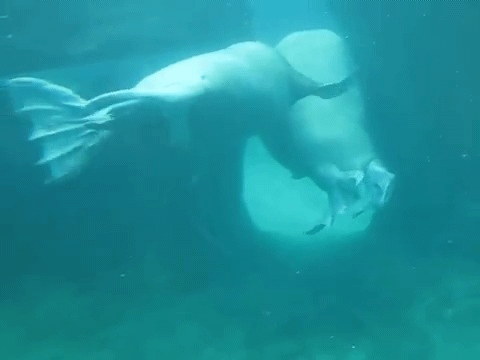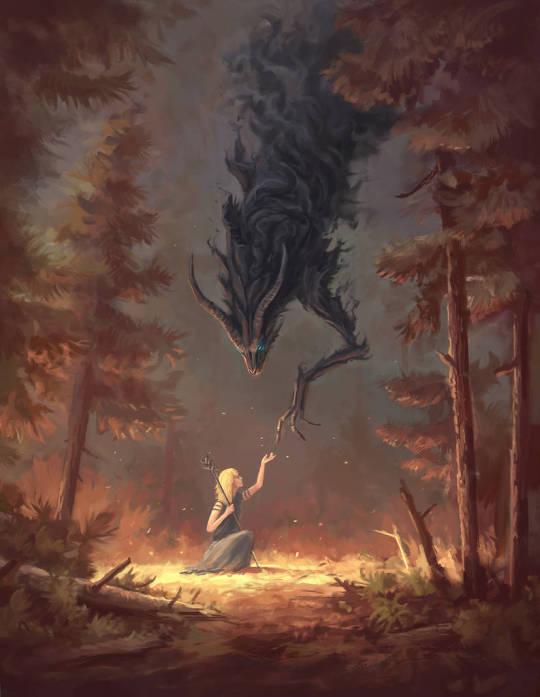#Odobenus
Photo

A walrus (Odobenus rosmarus) in Svalbard, Norway
by Fabrice Stoger
#walrus#seals#odobenus rosmarus#odobenus#odobenidae#pinnipedia#carnivora#mammalia#chordata#wildlife: svalbard#wildlife: norway
1K notes
·
View notes
Text

Walrus (Odobenus rosmarus), family Odobenidae, off the shore of Amsterdam Island, Spitsbergen, Norway
photograph by Aurora Lampson
195 notes
·
View notes
Text
Aylak Deniz Ayısı
Aylak Deniz Ayısı
Thor isimli Atlantik deniz ayısı (Odobenus rosmarus), Birleşik Krallık da bulunan Yorkshire kıyılarına kadar inmeye cesaret eden aynısı oldu. Yetkililer hayvanın korkup kaçmaması ve rahat rahat uyuması için rıhtımı kordon altına aldılar. O gün için planlanan havai fişek gösterisi de iptal edildi.
Bilim insanları, deniz ayısının Kuzey Kutbu’nun soğuk sularını terk edip neden bu…
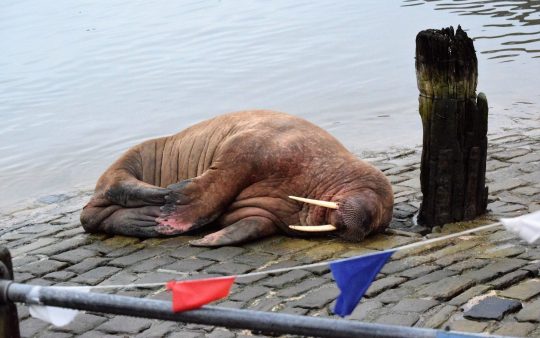
View On WordPress
0 notes
Text
indian bhai and behan hard sex stepcousin hindi sex
MILF dominatrix pegging sub and dickriding
jackpot casino carson city nv
busty ballerina
Hot, thin Latina tranny takes a huge cock in her mouth and ass
One Night in London
Vanessa Luna, Melanie Hicks
Two Hot Babes Fucked by One Guy
Day At The Spa Japanese Voyeur
Jerking off while driving
#emergency#witchercully#swarajist#kyacks#umteenth#drumlike#clevis#camisados#malversation#grossirete#reclassify#intransient#inferenced#bottle-feed#Odobenus#polyommatous#coralist#sex-limited#beanstalks#bar-tailed
0 notes
Text
They were playing and howling with joy, and not with anger.
"20,000 Leagues Under the Sea" - Jules Verne
#book quote#20000 leagues under the sea#twenty thousand leagues under the sea#jules verne#walrus#odobenus rosmarus#playing#joy
3 notes
·
View notes
Photo

A herd of Atlantic walrus (Odobenus rosmarus rosmarus) on Matveev Island, Russia.
(Photo: Yulia Bogomolova/WWF-Russia)
#yulia bogomolova#photographer#wwf-russia#canadian geographic#atlantic walrus#animal#mammal#walrus herd#odobenus rosmarus rosmarus#matveev island#russia#nature
9 notes
·
View notes
Note
I saw DILF OC and came running, tell me more about he
-kq
Ok so basically this guy is where Harp gets her height. He's 5 feet tall, chubby, he's got a mustache and a beard, and he's a great dad! He loves his three girls (Harp has 2 sisters) and his tall wife very much.
4 notes
·
View notes
Text
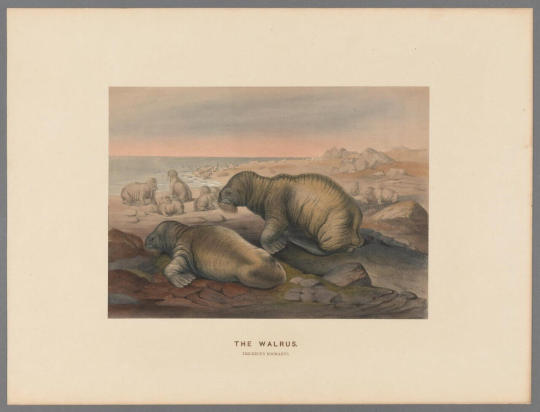
The Walrus (Trichecus rosmarus) | Joseph Wolf | Zoological sketches v.1 (1861) | Biodiversity Heritage Library | Flickr | Public domain
1 note
·
View note
Text
Overt sexual behavior between males takes the form of mounting (in shallow water): one male clasps another with his flippers from behind, thrusting his pelvis and erect penis against the other male's anal region.
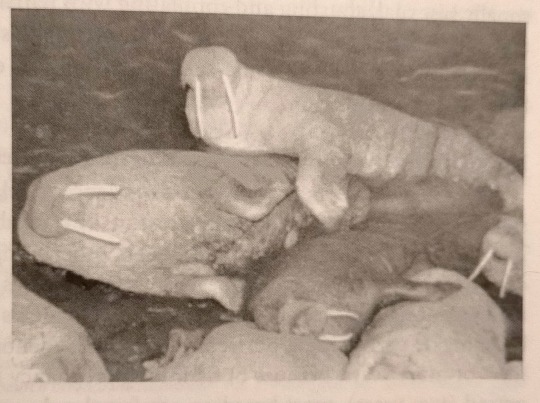
A male Walrus mounting another male off the coast of Round Island (Alaska), thrusting his erect penis (visible below the surface of the water) in the other male's anal region.
"Biological Exuberance: Animal Homosexuality and Natural Diversity" - Bruce Bagemihl
#book quotes#biological exuberance#bruce bagemihl#nonfiction#walrus#odobenus rosmarus#shallow water#round island#alaska#homosexual#gay
0 notes
Text
Most older males are seasonally bisexual, courting and copulating with females during the mating season and participating in same-sex activities during the summer and early fall; some, however, also engage in same-sex mounting and companionship during the breeding season.
"Biological Exuberance: Animal Homosexuality and Natural Diversity" - Bruce Bagemihl
#book quote#biological exuberance#bruce bagemihl#nonfiction#bisexual#same sex activity#summer#fall#autumn#mounting#companionship#breeding season#walrus#odobenus rosmarus
0 notes
Text
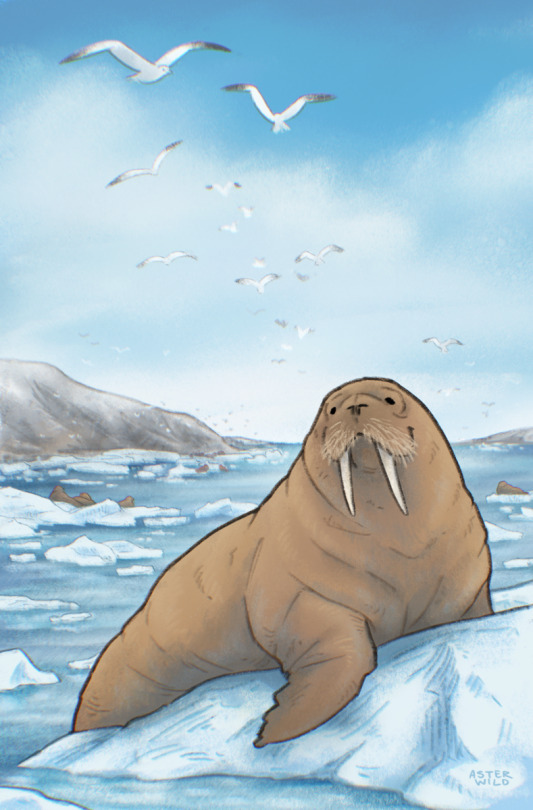
Walrus (Odobenus rosmarus), a large pinniped found in the arctic and subarctic.
created for the first @polarlightszine
#id in alt#walrus#i was going to reblog it For The Meme and realized i'd never posted the actual image here just the zine teaser and timelapse vid#anyway. he knocks on your door wyd#animals#wildlife#pinniped#marine mammal#arctic#animal art#illustration
370 notes
·
View notes
Text
Wet Beast Wednesday: walrus
There are a lot of iconic arctic animals, such as the polar bear and narwhal, but my personal favorite is the walrus. Known for their large tusks, prominent whiskers, and habit for busting myths creepy eyes, walruses are unique amongst the pinnipeds. Most people know of the two main groups of pinnipeds: Phocidae, the earless or true seals and Otariidae, the fur seals and sea lions. Walruses however are in a class of their own, being the only surviving species of their own family: Odobenidae. A weird fact that I learned researching for this is that taxonoimists used to think Odobenids evolved from bears before later reclassifying them alongside the other pinnipeds. Old-timey taxonomy was wild and came up with some absolutely unhinged ideas. Like they used to think that microbats and megabats weren't related, instead classifying megabats as primates.

(image; a walrus sitting on an ice flow. It is a large, brown mammals with short limbs that end in flippers. Its head has a wide, blunt snout and two long tusks emerging from the upper jaw)
There is one species of walrus, Odobenus rosmarus, divided into two subspecies based on location: the Atlantic walrus (O. r. rosmarus) and Pacific walrus (O. r. divergens). The two subspecies are still very similar and genetic testing indicates they diverged between 750,000 and 500,000 years ago. There used to be a third listed subspecies from the Laptev sea, O. r. laptevi, but they have since been reclassified as a population of the Pacific walrus. Walruses are very large, being the third largest pinnipeds after the two elephant seal species. The Pacific subspecies is larger than their Atlantic brethren with most males reaching an average weight between 800 and 1,700 kg (1,800 to 3,700 lbs). A few males have been known to grow considerably larger than average. Male Atlantic walruses average about 900 kg (2,200 lbs). In both subspecies, females are about 2/3 the size of males and have shorter tusks. a large portion of their weight comes from the thick layer of blubber under their skin that helps them stay warm. Both subspecies have an average length between 2.2 and 3.6 meters (7.4 to 11.8 ft). Walruses have hind flippers that can turn forward to act like feet, letting them crawl on all fours like sea lions. Like true seals, they have no external ears. The skin is very thick and mostly bald. They are born with brown skin that becomes lighter as they age. While swimming, the blood vessels in the skin construct to reduce blood flow and limit heat loss, which makes them considerably lighter, almost white. Males have skin nodules called bossed around the neck and shoulders. Their creepy eyes are the result of eye sockets with no roof and powerful extraocular muscles that let the eyes protrude out of the skull and look both forward and sideways. The famous mustaches are composed of 400-700 thick whiskers. The whiskers are attached to muscles and have both nerve ending and blood supply. They are incredibly sensitive sense organs and a walrus can identify objects as small as 2mm with its whiskers. Their lips are muscular and flexible and aid in creating a large variety of noises.

(image: a close-up of a walrus's face, showing its prominent whiskers and small eyes. Its mouth is open, revealing its tongue)
youtube
How come the walrus can whistle but I can't? (video: a walrus in a zoo being instructed by its handler to make multiple vocalizations)
Of course the most famous features of walruses are their tusks. These two large canines can reach a meter in length and are larger in males than females. The tusks have a number of uses in both sexes, though males use them more. In both sexes, they are used to help dig breathing holes in sea ice, hang onto ice and help the walrus climb out of the water. Males also use their tusks in displays of dominance, especially during mating season. Larger tusks are a sign of dominance and typically the walrus with the largest tusks will win standoffs. If a standoff escalates from posturing to a fight, they will use their tusks as weapons. They tend to strike around the neck and shoulders and the skin nodules in those areas help protect males from each other's tusks. It was formerly believed that walruses would use their tusks to dig for prey on the sea floor, but this is no longer believed to be the case.

(image: a walrus skull showing the tusks)

(image: a walrus using its tusks to hang onto the ice and keep its nostrils above the water)
Walruses spend a lot of their time searching for the food they need to support a body that big. They prefer forging along the continental shelf and spend much more time in shallow water than other pinnipeds. While walruses have been tracked diving 500 meters deep, the majority of dives are much more shallow. The vast majority of a walrus's diet consists of seafloor-dwelling invertebrates including tubeworms, soft corals, tunicates, crabs and shrimp, sea cucumbers, and mollusks. While that's a wide palette, their absolute favorite food is clams. To hunt, walruses drag their noses and the forward surface of their tusks through the sediment and use their whiskers to search for food. This stirs up the sediment and releases nutrients back into the water column, a process balled bioturbation. Many foods can be swallowed whole or chewed, but they have a special feeding style for clams and other bivalves. Walruses will hold the bivalve in their mouths and use their flexible lips to form a water-tight seal around it. It then withdraws its tongue into its mouth to create enough suction to suck the bivalve meat right out of the shell. So important is this strategy to feeding that the shape of their mouths is specially adapted to it. Walruses are also known to feed on seals, though how much of that is due to hunting or scavenging is unknown. Additionally, they will scavenge whales, may hunt walrus trapped under sea ice, and have been seen catching and eating birds.
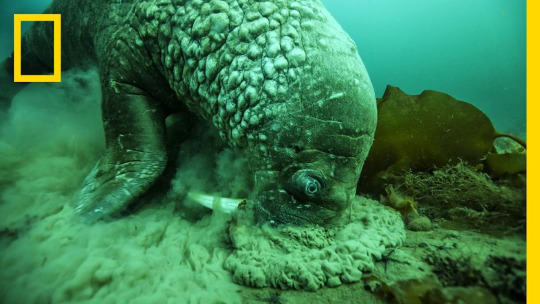
(image: a walrus foraging for food underwater. It has its snout pressed into the sea floor and is kicking up a large amount of sediment. Still from a National Geographic video)
Walruses are social and migratory, traveling south for the winter and north for the summer in aggregations that can be tens of thousands strong. They will haul out onto land or sea ice in huge numbers, blanketing the landscape in blubber and tusks. While these aggregations are preferred, they are not considered a true social species as they do not aid each other when together. Walruses on land or ice are skittish and will spook easily. Being startled can lead to stampedes while the walruses flee back to sea. Sometimes, walruses will be trampled to death during these stampedes. During mating season, the normally cordial walruses become much less friendly to their neighbors. Breeding seasons lasts from January to March. During this time, males will gather in the water around females in heat and compete for the change to get to that nice walrussy (I will not apologize). This is usually done via bellowing and posturing with the tusks, but may escalate to fights. While males become sexually mature around age 7, they often do not become large and strong enough to secure mates until around age 15. Females become sexually mature between 4 and 6 years old. Curiously, females enter heat twice per year, but males are only fertile once per year. Gestation takes up to 16 months and calves are born able to swim and weighing up to 75 kg (165 lbs). Females with calves move away from the large aggregations, possibly to keep their calves from being crushed in stampedes and possibly to make it harder for predators to detect their scent. Nursing lasts for over a year, longer than in many pinnipeds. Walrus milk is fattier than that of land mammals, but less fatty than that of true seals, forcing walrus mother to nurse longer. Even after being weaned, walruses may spend up to 5 years with their mothers. Females only mate at most every two years, which gives the walrus the lowest reproduction rate of all pinnipeds. Walruses can live up to 30 years in the wild and 40 years in captivity. Male walruses have the largest penis bone of any non-cetacean both in absolute size and proportionately.
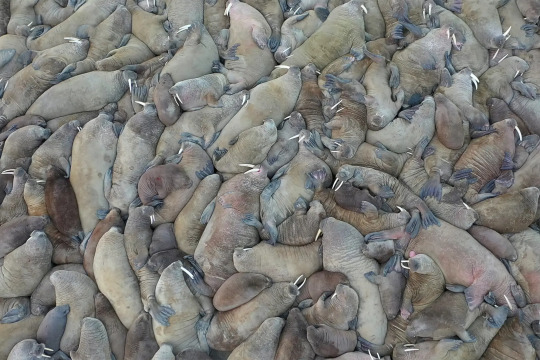
(image an aerial shot of a walrus herd on land. There are many walruses and they are so tightly packed together that no ground is visible)

"Don't talk to me or my son ever again" (image: a mother walrus with its calf. The calf is a smaller version of the mother with no tusks. The calf is sittting by its mother's side. Both are looking at the camers)
Walruses have been hunted by humans living in the arctic circle for millennia. Hunting peaked in 18th and 19th centuries when there was a high commercial demand for meat, blubber, skin, and ivory. This almost led to the extirpation of Atlantic walruses. Since then, hunting has been outlawed except by indigenous peoples, allowing the populations to recover. Now, the major threat to walruses is climate change leading to loss of sea ice needed for hauling out and breeding. The IUCN lists both subspecies as Vulnerable. They were an important source of food and other materials to the peoples of the arctic circle and appear frequently in the mythology of said peoples.

(image: a walrus tusk carved with the images of multiple fish, seals, and polar bears)
#wet beast wednesday#walrus#pinniped#marine biology#zoology#ecology#marine mammals#animal facts#biology#Youtube
503 notes
·
View notes
Photo
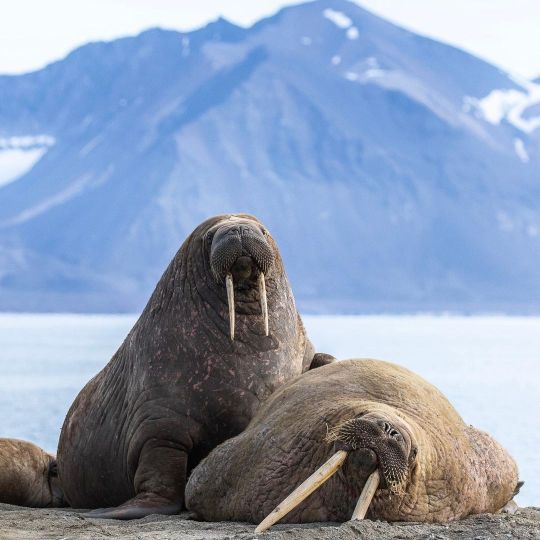
Go with the floe, just like a walrus! Though a walrus (Odobenus rosmarus) can spend about two-thirds of its life at sea, this massive pinniped still needs to “haul out” of the water to rest and birth its young. Ice floes provide a safe haven for baby walruses and a resting place for hungry adults—when they aren’t busy sucking up crabs, shrimp, and mollusks from the ocean floor. In fact, ice floes are so important to these marine mammals that they migrate long distances based on their movements. Some individuals can travel more than 1,863 miles (3,000 km) in a single year! Photo: sd_nature, CC BY-NC 4.0, iNaturalist https://www.instagram.com/p/CpNgGN9LV96/?igshid=NGJjMDIxMWI=
360 notes
·
View notes
Text
As in many other polygynous mammals, female Walruses generally raise their young on their own, occasionally supplemented with a number of alternative parenting arrangements.
"Biological Exuberance: Animal Homosexuality and Natural Diversity" - Bruce Bagemihl
#book quote#biological exuberance#bruce bagemihl#nonfiction#walrus#odobenus rosmarus#polygyny#child rearing
0 notes
